
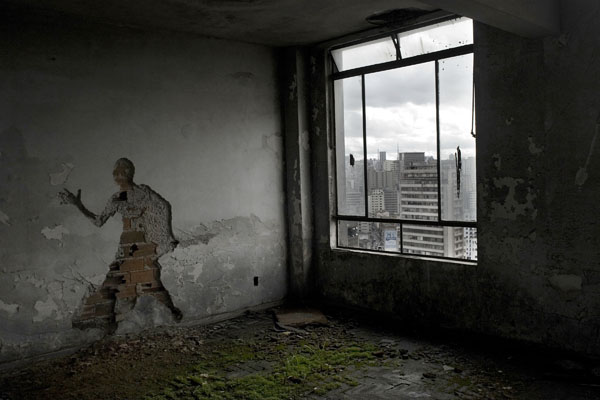
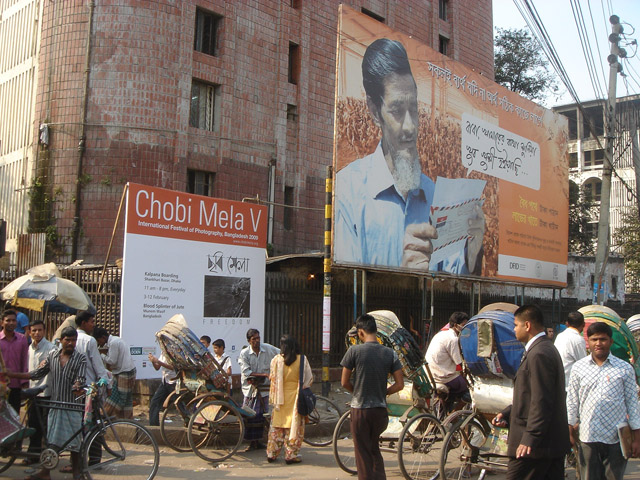
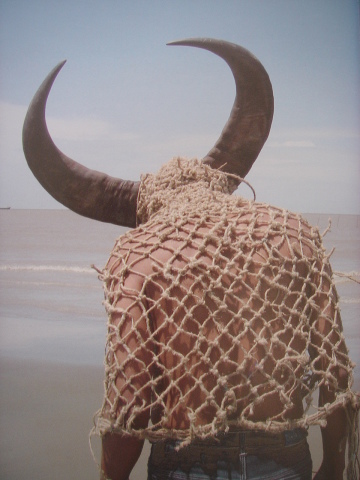
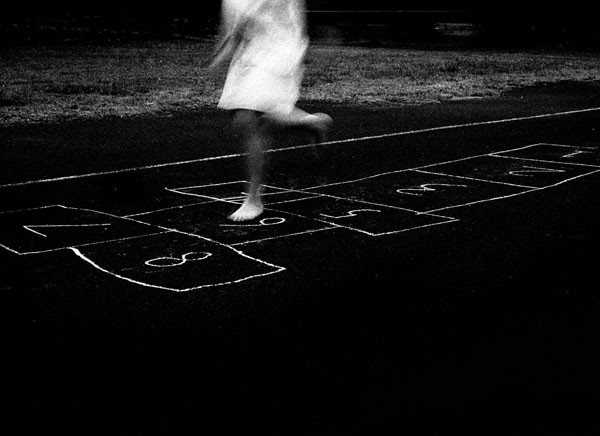
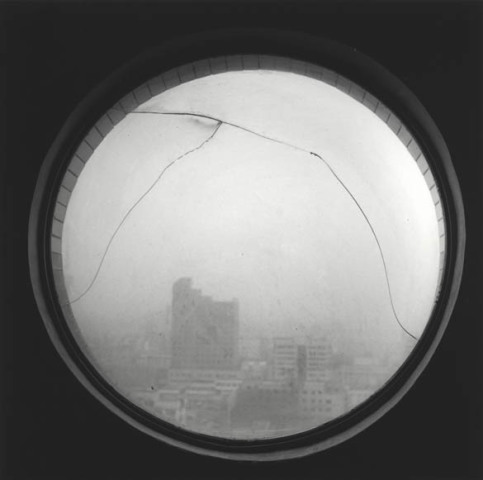
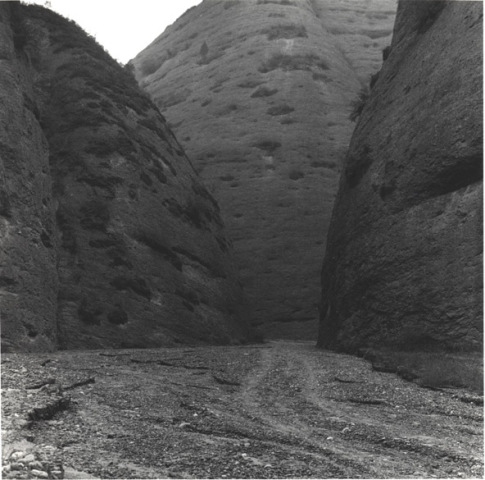
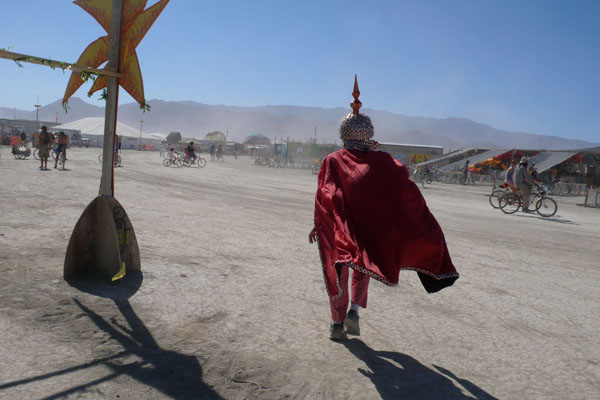
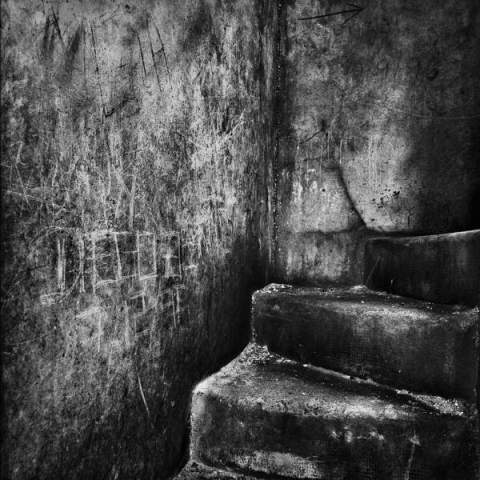


Chobi Mela V: Exhibition and Research
Location: Dhaka, Bangladesh
Drik is partnered with the Prince Claus Fund and Arthub.
Arthub in the year 2009-2010 will try to bring this partnership to the next level of co-operation. In doing so, supporting Chobi Mela V is a consequential decision.
Arthub invites Monica Dematte’ (curator) and Li Lang (photographer) to Dhaka for a series of talks, presentations and research. This project is also connected to mapping the new silk roads, which has been the focus of the research based projects of Arthub for the last year and it is the core of the organizations activities in 2009.
First Impression, a diary
by Monica Dematte’, February 2009
This is my first time to Bangladesh. I came for the Chobi Mela International Photo festival, and also because I wanted to have an idea of what was going on here in the contemporary visual art scene. I came without knowing anything of the history of the country, beside the tragic facts of the partition from India in 1947 and the independence war in 1971, when the country became Bangladesh and was no longer East Pakistan. A history of destruction, violence, struggle. The only thing I knew before coming was that Dhaka, the capital, was a very polluted and noisy city, with terrible traffic jams and poverty.
Coming from Kolkata, India, and having spent nearly one month in that country previously, Dhaka, instead, seems quite clean to me. It is true that there is dust everywhere, as it has not been raining for months, but the situation is not as bad as I thought.
This said, let’s switch straight to the contemporary art situation.
I had met Lipi and Mahbubur back in 2003, during a workshop in Lijiang, Yunnan, but they were in Nepal when I arrived to Dhaka. Through the names and contacts they gave me, and other local friends’ help, I managed to start my visits.
The first artist I got to meet is Ronni Ahmmed, born in 1971, graduated from the local Institute of Fine Arts (on Kazi Nazrul Islam Avenue, next to the National Museum), where most of the artists have studied. He lives in the northern part of the city, a rather new district called Uttara, which has been planned in a very regular, geometric way. He shows me his surrealistic paintings, his sculptures, even his sandals, made of recycled car tires. He is a 360 degrees creative person. He gives me an idea of the historical development of contemporary art in Bangladesh, starting from the pioneers: Zainul Abedin, the founder of the art institute and the most respected artist, S. M. Sultan and Hamrul Hasan, who mixed the folk art and the modernist trend.
He shows me a book titled ARTS and Crafts, a Cultural Survey on Bangladesh series. It is a quite exhaustive source regarding the art situation here up to 2007.
And an issue of Jamini, an International Art Quarterly published here. Then he mentions the fact that a friend of his, a collector and art mecenate, is going to support the creation of a new magazine which wants to achieve a true international standard. Ronni takes me to his friend’s Anis Moquit office. Anis is a managing director of a garment firm which realizes here clothes for some of the most famous brands, such as Armani and Calvin Klein.
Anis is an intelligent and warm man who has a good collection of artworks scattered around in the 6 floors building where he operates. Everything here is the result of a careful eye. He invites me to be a contributor of the new coming magazine, and I agree because I have the feeling that these people here are really driven by enthusiasm and a good understanding of art.
Ronni has now become my guide. He then takes me to the Bengal Foundation, an important institution here. The building lies on the way from Uttara towards town, surrounded by trees and in front of a small pound (New Airport Road, Civil Aviation, Plot 2). The general director, Luva Nahid Choudhuri, is a lovely lady who has been working here since its founding. The Bengal Foundation’s founder has collected about 3500 artworks, and many are showcased here. I have to say that the standard is high. They are now attempting to get some money from the government in order to build a museum and be able to show the works to the public. But I suspect Luva won’t part easily with the great painting which is hanging in her office, by S. M. Sultan.
The Bengal Foundation supports as well theater and music. In their gallery, Bengal Art Gallery (House 275/F, Road 27 (old), Dhanmond district), now showing a photographic exhibition which is part of the Chobi Mela (A people war, curated by Kunda Dixit from Nepal), there are frequent shows of contemporary artists. The director, Subir Choudhuri, is very busy in his office upstairs. The space is good and quite large, the café serves good food and the small garden outside gives a bit of rest from the city’s noise.
Ronni then takes me to his friend’s Mostafa Zaman’s house. Mostafa is a painter, a writer and a critic. He is preparing the works for the next show coming up. But I feel that the realm where he feels more at easy is the linguistic one. He tells me about the philosophical and poetic tradition in Bengal, and I have a feeling that it must be really deep. I decide I will do some research on it.
It is dark and we move to the studio of another artist. He is Monirul Islam, called Monir, who has been living in Spain, Madrid, for forty years and now he comes back often to work and see his friends. He is 65 with the energy and the wit of a young person. He paints abstract works, often on paper, juxtaposing dreaming colors. He offers us a snack, some pop rice with onions, tomatoes, chili and mustard oil (moori). I have seen it many times on the street, but never dared to try it. It is really good and unusual. We talk about the artistic situation here. He advocates more interest from the outside world, and a more open attitude by the artists here. I feel that the intellectuals here feel sorry for the difficult economic and social situation, but they are all very proud of their cultural heritage end of their people. I am sure the country, if leaded by honest politicians, will have the chance to become an important one. Everyone here has a spiritual interest, and there is no religious pressure. The Muslims, who are the majority, admit that their culture’s richness has a lot to do with the Hindu tradition, and they are willing to keep a multi-cultural approach and openness.
The day is coming to an end, and we have dinner at the Star Kebab, a very famous restaurant which mainly serves meat (kebab) but also has some vegetables. We have nan (a kind of bread) instead of the universally present rice.
The day after I go to the Institute of Fine Arts, which someone has described to me as a paradise. It is located between the National Museum and the Dhaka University. There are many trees, a large (dry) circular pond, and many nice corners. The building was designed by one of the most important architects and it has its charm. It was built taking into consideration local materials and climatic needs. The plan is quite complex, resembling a kind of composite T which has a curve in the upper part, so that it embraces the pond.
Shishir Bhattacharjee, Wakilur Rahman and other painters are sitting in the office of the painting department. I am afraid of disturbing their meeting, but instead they say they were just gossiping.
Shishir is an influential painter here, and Wakilur has moved to Berlin long ago, but he has studied in the Beijing Central Academy of Fine Arts in the years 83 to 86, and speaks Chinese. We have common friends! They were both born in the beginning of the 60s and in the Nineties were joining a group called Time. Now they work independently, but they are still great friends. The atmosphere is relaxed. I am offered tea, we manage to go into deep conversations very quickly. That’s what happens here all the time. No talking about the weather or such, we go directly into autobiographical experiences and political, social, artistic issues of course.
Rokeya Sultana is an established woman artist who graduated from the school of Santiniketan, near Kolkata, founded by Rabindranath Tagore, where people like the Nobel prize Amartya Sen have studied. The relation between Bangladesh and the west part of Bengal, namely the Kolkata region, is very strong. They do not really feel they belong to different countries, rather that they are all Bengali. No wonder, Bangladesh has chosen a song by Tagore as the national anthem, just like India. Rokeya has painted many nudes and is therefore considered pretty daring, in a Muslim society. She tries to express the desires of women in a society where women are mainly considered ‘mothers’. Her husband is a famous musician, and her daughter, who is now 24, is studying economy at the university, but she also is a singer and a composer and has her own band.
When she performances she wears jeans and not the shalwar (long chemise on wide pants, typical outfit for women in the North of India and in Pakistan) she has today, which are expected when attending class.
We have a lunch and a long conversation with Rokeya. She now teaches at the printmaking department of the Art Institute.
She, like the other artists and professors there, laments the lack of proper spaces to use as a studio. In fact I have realized that all the artists I have visited paint at home, in narrow and messy spaces. It reminds me of China when I first went there in late 80s.
Lipi Mayeba and Mahbubur Rahman have now come back form Nepal and I visit them. They are also founders and trustees of the artistic residence and studio Britto, which often organizes workshops for and with local and international artists.
Beside painting, the two (wife and husband) make performance art and installation. Mahbubur is an extremely creative artist, I remember that when he came to Lijiang he used all possible media he could find. He is very interested in many different and unusual materials, and of folk motifs. The two combine ideas coming from their life experience and the society around them, with their own sensibility.
They advice me to go to visit artists in the second city of Bangladesh, Chittagong, and as I have decided to extend my staying here, that’s what I am going to do in the next days.
I hope I will be able to update you on that.
Welcome to Bangladesh, a country where the warmth and depth of the people will make you forget the lack of some material commodities!
Side activities:
Bengal Gallery of Fine Arts organized a lecture session titled An autobiographical survey of Chinese Contemporary Art, the last 20 years accompanied by audiovisual presentation by visiting Italian curator Monica Dematte on 24th February 2009, Tuesday at 5:00 at Bengal Shilpalaya.
About Chobi Mela V
Right from its inception Chobi Mela has faced adversity. The initial attempt in 1995 coincided with the first one week ‘hartal’ in the country. It took us five years to recover. Chobi Mela I, held in January 2000, featured the unique exhibition The War We Forgot, featuring some the greatest names in photography, Abbas, David Burnett, Don McCullin, Kishore Parekh, Marc Riboud, Mary Ellen Mark, Marylin Sylverstone, Raghu Rai, Rashid Talukder and Raymond Depardon who documented the war of liberation of Bangladesh in 1971. The show was curated by Robert Pledge and myself, but the night before the show was to open, a government directive came to remove some of the photographs. The government wanted a sanitised version of the war. We refused to buckle and rather than censor the work, relocated from the National Museum to our own gallery in Dhanmondi. Polly Hope’s exhibition which was then being shown in the Drik Gallery was hastily relocated to make room for The War We Forgot.
The pattern has continued, with Chobi Mela constantly pushing the limits. Chobi Mela IV was no exception. With the streets of Dhaka in flames, we calmly proceeded to hold an international festival of photography. Robert Pledge was with us again, with the Contacts 30 show at the National Museum. During his talk at the Goethe Institut, we were informed that the government had declared emergency, the military was in the streets and that a curfew was to be enforced in 90 minutes. The audience was unperturbed and wanted the show to continue. Robert calmly finished his lecture before we bundled everyone out of the Goethe Institut Auditorium into the empty winter streets.
The situation this time was somewhat different. The nation is still under emergency rule, but that was not the cause of the problem. Chobi Mela has grown enormously over the years and both the quality and quantity of entries far exceeded previous submissions. Unknown photographers from countries never before featured submitted strong work. We needed to ensure venues for this vast collection. We had informed the National Museum and Shilpakala Academy (The Academy of Fine and Performing Arts) way in advance. The booking sheets were empty, but unofficially we were told that ‘the government had plans’ for these venues. Insiders warned us that our resistance to the proposed Guimet exhibition was part of the equation. Bureaucrats had long memories.
After weeks of no response, we approached the adviser Rasheda K Chowdhury. She was helpful, but that didn’t seem to make much difference. October, November and December were apparently kept in reserve for these ‘plans’. There was no way we could accommodate this expanded festival without these major venues, so we reluctantly decided to shift to January 2009. Again there was a hold up. This time the Victoria Memorial in Kolkata had made a tentative enquiry for January 2009. No dates had been provided. The museum was stalling again. Meanwhile Zhuang Wubin came up with the useful information that the Chinese New Year was on the 26th January. I hurriedly checked with Dave Clark and Davide Quadrio, to see how crucial this would be. With that in mind, and the floating dates for Victoria Memorial, I approached the adviser again. We opted for the 29th January 2009. Pushing it further back would encroach upon the 21st February and its associated events. Finally last night the Director General of the Museum gave us his nod. It couldn’t be the 29th. Thursdays were out. So we settled for the 30th instead. All the usual caveats were invoked. The government could cancel at any moment. There were no guarantees. But we’ve worked with these restrictions before. The 30th January 2009 it is.
While many have welcomed the new dates, others have faced disappointments. Wubin had purchased non-refundable tickets. Line Kristin Woldbeck and Arne Stromme whom I’d met during a lecture in Kristiansund had taken leave from work and booked holidays to coincide with the festival. Pedro Meyer and Nadia Baram along with their entourage of 30 Mexican photographers were unable to reschedule. Jan Gruvborg had to reluctantly drop out. Others however have found the new dates preferable, and some like Mark Sealy are able to make it because of the changes. Marcelo Brodsky hopes to come with his wife Gianna for a holiday!
Now with the venues settled we can start with the long overdue allocation of shows to spaces and make the final decision of which work to feature. Even with the venues being obtained there will be good deserving work which will sadly be left out. But we will have a great festival. Start preparing for the opening on the 30th January 2009. We’ll party all night!
Welcome to Dhaka.